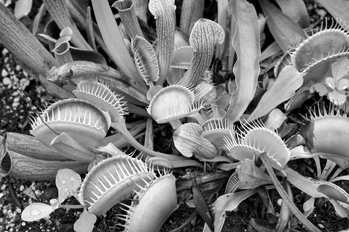Venus Flytrap
 The Venus flytrap (Dionaea muscipula), one of the few carnivorous plants on earth, grows naturally along a small section of the North Carolina and South Carolina coastline within a 75-mile radius of Wilmington. It prospers only in humid, boggy areas such as the Carolina Bays. The traps, which grow in a rosette, are formed by pairs of modified leaves that resemble clam shells and have spikes along their edges; the inner surfaces of the leaves are equipped with reddish glands that attract insects and arachnids. When an insect touches this surface twice in rapid succession, tiny hairs act as a trigger to close the trap rapidly. Digestion requires seven to ten days depending upon the size of the insect. In 1750 North Carolina's royal governor, Arthur Dobbs, called attention to this unusual plant, described as a "carnivorous vegetable" by botanist William Bartram in 1794. Charles Darwin described it in Insectivorous Plants (1875) as "the most wonderful plant in the world."
The Venus flytrap (Dionaea muscipula), one of the few carnivorous plants on earth, grows naturally along a small section of the North Carolina and South Carolina coastline within a 75-mile radius of Wilmington. It prospers only in humid, boggy areas such as the Carolina Bays. The traps, which grow in a rosette, are formed by pairs of modified leaves that resemble clam shells and have spikes along their edges; the inner surfaces of the leaves are equipped with reddish glands that attract insects and arachnids. When an insect touches this surface twice in rapid succession, tiny hairs act as a trigger to close the trap rapidly. Digestion requires seven to ten days depending upon the size of the insect. In 1750 North Carolina's royal governor, Arthur Dobbs, called attention to this unusual plant, described as a "carnivorous vegetable" by botanist William Bartram in 1794. Charles Darwin described it in Insectivorous Plants (1875) as "the most wonderful plant in the world."
In 1934 the Venus flytrap was made the official flower of the Garden Clubs of North Carolina, and after a number of years it grew in popularity. Poachers began to dig the plant for sale; the Venus flytrap was officially protected by legislation in 1951.
References:
William C. Coker, "Distribution of Venus's Fly Trap," Elisha Mitchell Scientific Society Journal 43 (July 1928).
W. Charles Nelson, Aphrodite's Mousetrap (1990).
Patricia R. Roberts, "Response of Venus Fly Trap," Ecological Monographs 28 (April 1958).
Additional Resources:
An Act to Adopt the Venus Flytrap as the Official Carnivorous Plant of the State of North Carolina. North Carolina General Statutes§ 145-22. (passed June 7, 2005). https://www.ncleg.net/sessions/2005/bills/senate/pdf/s116v4.pdf (accessed June 28, 2012).
Meeker-O'Connell, Ann. "How Venus Flytraps Work" HowStuffWorks.com http://science.howstuffworks.com/environmental/life/botany/venus-flytrap.htm (accessed June 28, 2012).
Tucker, Abigail. "The Venus Flytrap's Lethal Allure." Smithsonian Magazine, February 2010. http://www.smithsonianmag.com/science-nature/The-Venus-Flytraps-Lethal-Allure.html (accessed June 28, 2012).
"Venus Flytrap." The Nature Conservancy. http://www.nature.org/ourinitiatives/regions/northamerica/unitedstates/northcarolina/explore/venus-flytrap-brochure.pdf (accessed June 28, 2012).
Baker, Mike/Associated Press. "Venus flytraps are trapped in a shrinking natural habitat" USA TODAY October 5, 2008. http://www.usatoday.com/tech/science/environment/2008-10-05-venus-flytraps_N.htm (accessed June 28, 2012).
Image Credits:
A cluster of Venus flytraps (with spiked “traps”) and pitcher plants growing in southeastern North Carolina. Photograph by Johnny Randall.
1 January 2006 | Stinson, Craig M.